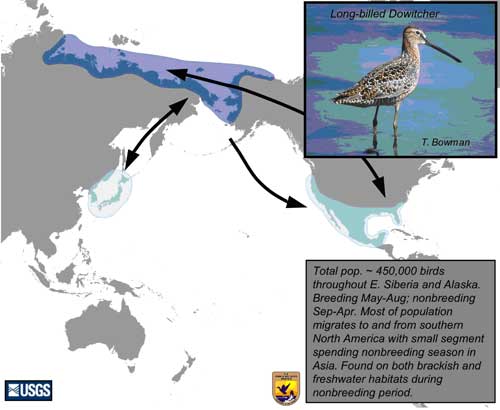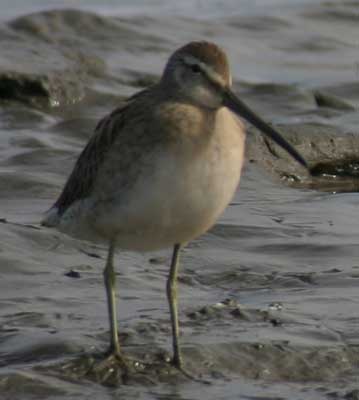Long-billed Dowitcher, Limnodromus scolopaceus
High-Priority Species ListNearly all the Long-billed Dowitchers that breed in Asia migrate through Alaska en route to non-breeding areas in North and Central America. These birds mix during migration and breeding with other waterfowl and shorebird species from parts of Asia with recent outbreaks of Asian H5N1.
The Long-billed Dowitcher is a common breeding shorebird at high-latitude coastal wetlands in Alaska, Canada, and the Russian Far East (Takekawa and Warnock 2000). About one-third of all Long-billed Dowitchers breeds in Asia, with the majority of these Asian-breeding dowitchers passing through Alaska during both spring and fall migration (Alaska Shorebird Group 2006-2010). Nearly all Long-billed Dowitchers spend the non-breeding season at sites in North and Central America (Takekawa and Warnock 2000), with the remainder wintering in Japan (Wild Bird Society of Japan 1982). The non-breeding range of the Long-billed Dowitcher in Asia is near sites of recent Asian H5N1 outbreaks, and during migration and on Russian breeding grounds dowitchers likely mix with other species of birds that frequent outbreak sites (e.g., Bar-tailed Godwits, Dunlin, Sharp-tailed Sandpipers). These different breeding and non-breeding groups intermix during spring and fall migration in Alaska, making the Long-billed Dowitcher a potential vector of Asian H5N1 virus in North America.
No. of samples: Total of 200 from Alaska.
Sampling locale: Primary sample locations include sites around Cook Inlet (Anchorage Coastal Wildlife Refuge, Susitna Flats State Game Refuge), Yukon-Kuskokwim Delta (YKD; coastal and inland sites adjacent to Hazen Bay and St. Michael), and the North Slope (Barrow, Canning River, Prudhoe Bay, Teshekpuk Lake).
Sampling timeframe: During May at Anchorage Coastal Wildlife Refuge, Susitna Flats State Game Refuge, and YKD. During this period, sampling will focus on shallow freshwater ponds adjacent to coastal mudflats where dowitchers gather during migration. Samples obtained in June on the breeding grounds would be collected on the North Slope. During fall staging/migration (July-August), samples will be collected on YKD (Tutakoke River).
Sample demographics: Adults will be sampled during migration in the spring and at breeding sites. Juveniles occur regularly but in sparse numbers in autumn at coastal sites in western Alaska.
Methods of capture: The sample goal of 200 can most easily be achieved through live trapping (e.g., walk-in traps, noose mats, mistnets) and/or collection of fecal samples from birds in spring. Smaller numbers of samples could be obtained from lethal capture (~20-40 birds). While breeding, Long-billed Dowitchers nest at low densities and are very difficult to capture on the nest, but can likely be captured post-hatch by utilizing chick distress playback calls.
Other targeted species: It will be possible to sample small to moderate numbers of Bar-tailed Godwits, Ruddy Turnstones, Dunlin, and Rock Sandpipers at the proposed sampling sites.
Sampling locale: Primary sample locations include sites around Cook Inlet (Anchorage Coastal Wildlife Refuge, Susitna Flats State Game Refuge), Yukon-Kuskokwim Delta (YKD; coastal and inland sites adjacent to Hazen Bay and St. Michael), and the North Slope (Barrow, Canning River, Prudhoe Bay, Teshekpuk Lake).
Sampling timeframe: During May at Anchorage Coastal Wildlife Refuge, Susitna Flats State Game Refuge, and YKD. During this period, sampling will focus on shallow freshwater ponds adjacent to coastal mudflats where dowitchers gather during migration. Samples obtained in June on the breeding grounds would be collected on the North Slope. During fall staging/migration (July-August), samples will be collected on YKD (Tutakoke River).
Sample demographics: Adults will be sampled during migration in the spring and at breeding sites. Juveniles occur regularly but in sparse numbers in autumn at coastal sites in western Alaska.
Methods of capture: The sample goal of 200 can most easily be achieved through live trapping (e.g., walk-in traps, noose mats, mistnets) and/or collection of fecal samples from birds in spring. Smaller numbers of samples could be obtained from lethal capture (~20-40 birds). While breeding, Long-billed Dowitchers nest at low densities and are very difficult to capture on the nest, but can likely be captured post-hatch by utilizing chick distress playback calls.
Other targeted species: It will be possible to sample small to moderate numbers of Bar-tailed Godwits, Ruddy Turnstones, Dunlin, and Rock Sandpipers at the proposed sampling sites.
U.S. Fish and Wildlife Service
Yukon Delta NWR (May, July-August)
U.S. Geological Survey
Migratory Bird Management (May, Barrow)
Contact: Richard Lanctot
Contact: Richard Lanctot
Yukon Delta NWR (May, July-August)
Contact: Brian McCaffery
U.S. Geological Survey
Alaska Science Center - Shorebird Project
Contact: Robert Gill
Contact: Robert Gill
Alaska Shorebird Group. 2006-2010. A Conservation Plan for Alaska Shorebirds. Unpublished report, Alaska Shorebird Group. Available through U.S. Fish and Wildlife Service, Migratory Bird Management, Anchorage, Alaska. XX pp.
Wild Bird Society of Japan. 1982. A field guide to the birds of Japan. Wild Bird Society of Japan. Tokyo.
Takekawa, J. Y., and N. Warnock. 2000. Long-billed Dowitcher (Limnodromus scolopaceus). In The Birds of North America, No. 493 (A. Poole and F. Gill, eds.). The Birds of North America, Inc., Philadelphia, PA.

Ranking Score: 12.0
Asian H5N1 ranking criteria for Long-billed Dowitcher, Limnodromus scolopaceus.
Total of partial contact with Asia1 |
Contact with known "hot spot"2 |
Habitat used in Asia3 |
Pop. in Alaska4 |
Can samples be obtained? |
Score |
3.0 |
1.0 |
3.0 |
3.0 |
2.0 |
12.0 |
>30% of pop. breeds in Russia where range expanding w. to Taimyr Penin., >95% of entire pop. winters in N. & C. America. Unknown numbers winter in Asia (Japan) |
No known use of AI-infected areas |
Breeds coastal lowlands in wet, grassy freshwater meadows; uses estuarine and managed wetlands during migration and winter |
North American pop. 450,000 (>90% of this is in Alaska during migration) |
Could be difficult to obtain target number |

